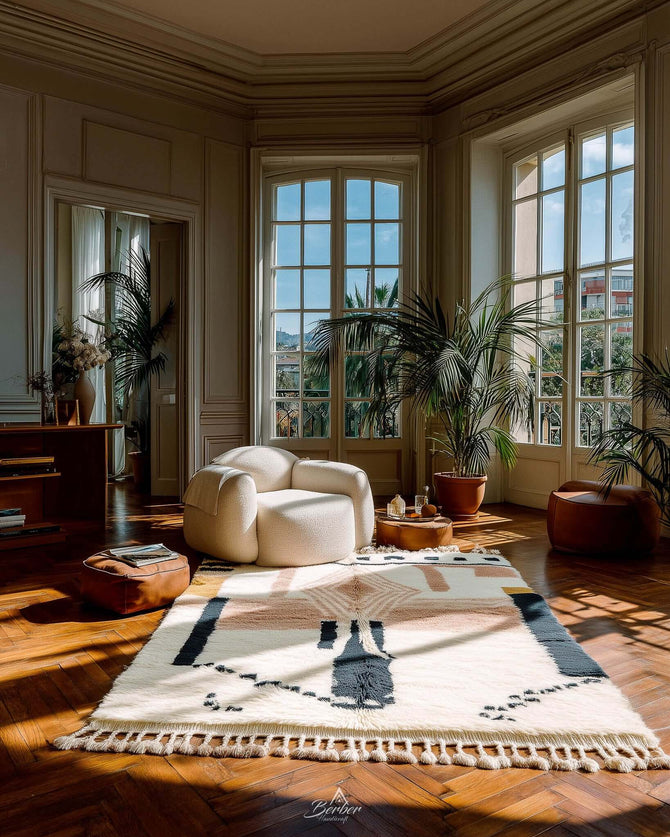Moroccan rugs go beyond being floor decorations. They stand as elaborate masterpieces that narrate tales of age-old customs and cultural values through the hands of talented craftsmen. In our journey through the art of rug weaving, we'll uncover the captivating methods used, the symbolic designs intertwined within them, and the profound significance infused in these fabrics.
 Exploring the Standing Heritage of Rug Weaving
Exploring the Standing Heritage of Rug Weaving
Weaving rugs is a tradition that dates back to ancient times and holds a special place in Berber culture. Throughout generations, in villages and towns, women have handed down the art of rug weaving from mother to daughter. This practice has helped preserve a legacy that is cherished by many. Every Berber rug tells its own story, reflecting the weaver's imagination, personal journey, experiences, and cultural influences.
Crafting Methods

Tying Knots by Hand
Moroccan rugs of high quality, like the renowned Beni Ourain rugs, are handmade through a process of knotting wool onto the threads of a loom to create patterns and designs that showcase the rug's craftsmanship and longevity.
Woven Flat
Flatweave Berber rugs, such as Kilims, are made by weaving the threads with the warp to create a flat and reversible rug without a pile of yarn. This technique enables detailed geometric designs and results in light and versatile rugs beloved by many.
Cyclic Stack
Certain Moroccan rugs showcase a loop pile construction, where the wool loops through the backing without being cut. This method is known for producing textured surfaces, commonly found in Berber carpets.
Plush Rugs
Cut pile rugs have loops that are trimmed to produce a velvety and comfortable surface, commonly found in Moroccan-style rugs, providing a luxurious sensation when walking or standing on them.
Craftsmen's Essentials

Moroccan rug makers typically employ simple yet efficient tools:
- Loom: The frame, whether horizontal or vertical, is used to keep the threads tightly stretched.
- Shuttle: A device used to weave the threads through the warp in the fabric-making process.
- Comb: Used to press the threads together, ensuring a dense weave.
- Scissors: Employed to tidy up the rug's fibers and give it a polished look.
The Significance of Symbols

Moroccan rugs are filled with symbolism; each design holds its own significance. Here are a few prevalent symbols:
Shapes with Defined Angles and Sides
- Diamonds: Represent fertility and femininity.
- Triangles: Symbolize a shield against the evil eye.
- Chevron: Often associated with water or rivers, representing purification and purity.
The Use of Animal Themes
- Birds: Symbolize fortune and joy, bringing luck and happiness.
- Fish: Reflect abundance and the ability to thrive, symbolizing prosperity and growth.
- Snakes: Represent protection against adversaries.
- The Tree of Life: Symbolizes progress and resilience, connecting us to the world around us.
- Stars: Represent spirituality and a deep connection to the universe.
- Mountains: Stand for resilience and timelessness.
The Meaning Behind Colors in Symbols

Moroccan rug colors are carefully chosen, each holding its own significance:
- Red: Symbolizes strength and safety.
- Blue: Signifies wisdom and truth.
- Green: Reflects serenity and harmony.
- White: Represents purity and cleanliness.
- Black: Symbolizes fertility and love.
Differences in Various Regions

Each region in Morocco has its own approach to rug making through different weaving techniques:
- The Middle Atlas region is known for rugs with intricate geometric patterns.
- The High Atlas region features striking designs and vibrant hues.
- Taznakht is famous for its diamond patterns.
The Art of Weaving

The process of rug weaving involves several key steps:
- Washing the wool, then carding and spinning it into yarn.
- Coloring the yarn with dyes derived from plants and minerals.
- Setting up the loom by arranging the threads in place.
- Weaving the threads through the warp to form the rug's pattern.
- Drying the rug before adding any final details.
Contemporary Advances

In addition to traditional methods, modern approaches are being adopted in Moroccan rug weaving:
- Using eco-friendly materials such as recycled fabrics.
- Exploring new styles while upholding traditional techniques.
- Appealing to customers by using natural and environmentally friendly dyes.
In Summary
Moroccan rug weaving showcases the talent and cultural heritage of artisans in Morocco, through designs and stories woven into each piece. These rugs use wool as a medium for both tradition and artistic expression. Whether you are a collector, a design enthusiast, or simply someone who appreciates beautiful craftsmanship, Moroccan rugs transport you to a captivating realm of culture and creativity. Keep in mind that each Berber rug tells a story beyond its patterns, holding the essence of ancient traditions and skilled craftsmanship passed down through generations.




